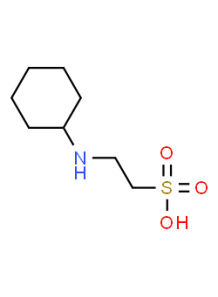CHES, 2-(Cyclohexylamino)ethanesulfonic acid
- Product Code: 35438
CHES, or 2-(Cyclohexylamino)ethanesulfonic acid, is a commonly used buffer compound in biochemical and molecular biology applications.
- -
- -
- -
- -
- -
- -
- -
- -
- -
- -
- -
- -
- -
- -
- -
- -
- -
- -
| Test Name | Specification |
|---|---|
| Appearance | White crystal |
| Assay (%) | 99 Min |
| Solubility (0.1M aq.) | Clear, colorless solution |
| Loss on drying (%) | 1 Max |
| pH (1% aq.) | 5-6 |
| Ultraviolet Absorbance (0.1M aq., 260nm) | 0.05 Max |
| Ultraviolet Absorbance (0.1M aq., 280nm) | 0.04 Max |
CHES, or 2-(Cyclohexylamino)ethanesulfonic acid, is a commonly used buffer compound in biochemical and molecular biology applications.
1. Chemical Structure and Properties:
- CHES is a zwitterionic buffer compound containing a cyclohexylamine group and a sulfonic acid group.
- It is a white, crystalline powder that is highly soluble in water and other polar solvents.
- CHES has a pKa value of around 9.5, making it useful for maintaining an alkaline pH range.
2. Applications:
- Protein Purification: CHES is often used as a buffer component in protein purification techniques, such as ion-exchange chromatography and affinity chromatography.
- Enzyme Assays: CHES buffers can help maintain the optimal pH environment for enzymatic reactions and activity measurements.
- Nucleic Acid Manipulation: CHES can be used as a buffer in applications involving DNA and RNA, such as gel electrophoresis and enzymatic reactions.
- Cell Culture: CHES may be included in cell culture media to help maintain the desired pH range for cell growth and metabolism.
3. Advantages:
- pH Buffering Range: CHES is effective in maintaining a pH range of approximately 8.6-10.0, making it suitable for applications that require an alkaline environment.
- Compatibility: CHES is generally considered a biocompatible buffer and is widely used in biological and biochemical applications.
- Solubility: CHES has good solubility in water and other polar solvents, allowing for easy preparation of buffer solutions.
4. Considerations:
- Temperature Dependence: The pH of CHES buffer solutions can be affected by temperature, so the pH should be carefully monitored and adjusted as needed.
- Potential Interactions: Like any buffer, CHES may interact with certain compounds or materials, so its compatibility should be evaluated for specific applications.
Overall, CHES is a versatile buffer compound that is commonly used in a variety of biochemical and molecular biology applications, particularly in the areas of protein purification, enzyme assays, and nucleic acid manipulation.
Be the first to review this product :-)
Recommend Lab-Service
| Lab Service | Price |
|---|

CHES, or 2-(Cyclohexylamino)ethanesulfonic acid, is a commonly used buffer compound in biochemical and molecular biology applications.
CHES, or 2-(Cyclohexylamino)ethanesulfonic acid, is a commonly used buffer compound in biochemical and molecular biology applications.
1. Chemical Structure and Properties:
- CHES is a zwitterionic buffer compound containing a cyclohexylamine group and a sulfonic acid group.
- It is a white, crystalline powder that is highly soluble in water and other polar solvents.
- CHES has a pKa value of around 9.5, making it useful for maintaining an alkaline pH range.
2. Applications:
- Protein Purification: CHES is often used as a buffer component in protein purification techniques, such as ion-exchange chromatography and affinity chromatography.
- Enzyme Assays: CHES buffers can help maintain the optimal pH environment for enzymatic reactions and activity measurements.
- Nucleic Acid Manipulation: CHES can be used as a buffer in applications involving DNA and RNA, such as gel electrophoresis and enzymatic reactions.
- Cell Culture: CHES may be included in cell culture media to help maintain the desired pH range for cell growth and metabolism.
3. Advantages:
- pH Buffering Range: CHES is effective in maintaining a pH range of approximately 8.6-10.0, making it suitable for applications that require an alkaline environment.
- Compatibility: CHES is generally considered a biocompatible buffer and is widely used in biological and biochemical applications.
- Solubility: CHES has good solubility in water and other polar solvents, allowing for easy preparation of buffer solutions.
4. Considerations:
- Temperature Dependence: The pH of CHES buffer solutions can be affected by temperature, so the pH should be carefully monitored and adjusted as needed.
- Potential Interactions: Like any buffer, CHES may interact with certain compounds or materials, so its compatibility should be evaluated for specific applications.
Overall, CHES is a versatile buffer compound that is commonly used in a variety of biochemical and molecular biology applications, particularly in the areas of protein purification, enzyme assays, and nucleic acid manipulation.
| Mechanism | - |
| Appearance | - |
| Longevity | - |
| Strength | - |
| Storage | - |
| Shelf Life | - |
| Allergen(s) | - |
| Dosage (Range) | - |
| Recommended Dosage | - |
| Dosage (Per Day) | - |
| Recommended Dosage (Per Day) | - |
| Mix Method | - |
| Heat Resistance | - |
| Stable in pH range | - |
| Solubility | - |
| Product Types | - |
| INCI | - |
Cart
No products



